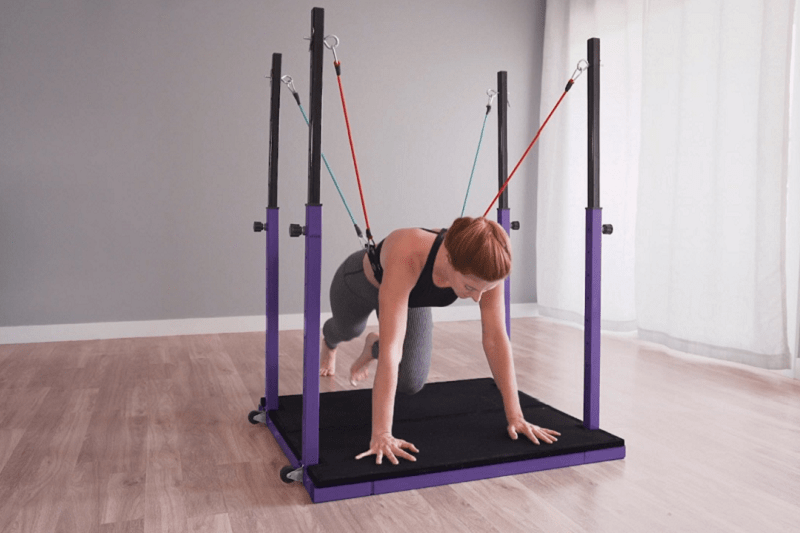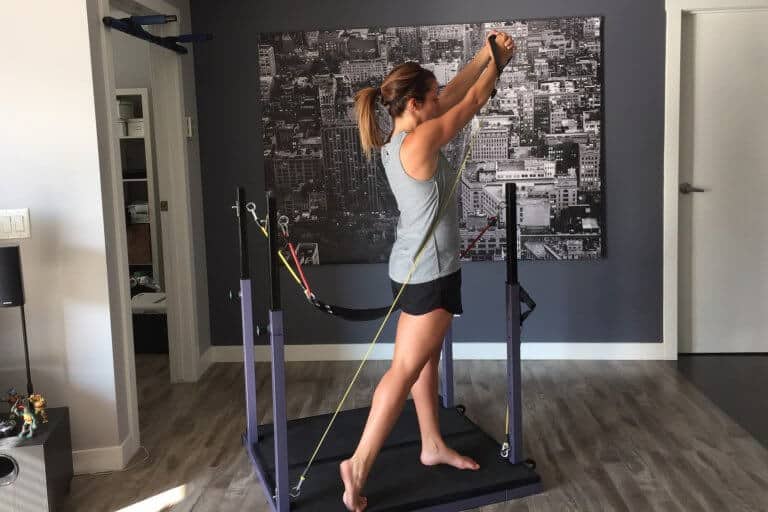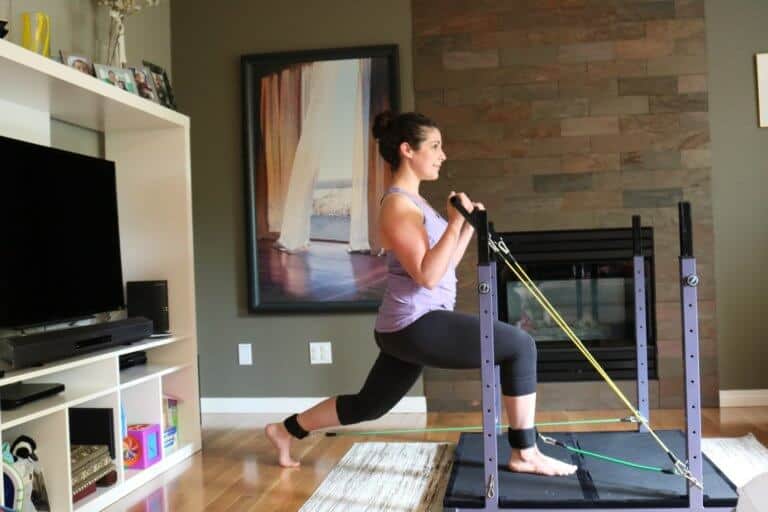
Resistance Bands vs. Weights | 7 Exercises You Need to Try With Resistance Bands
There are many reasons for you to exercise. Whether it's for strength, endurance, muscle tone, rehabilitation, or general health, the question of resistance bands vs. weights is one that comes up often.
Here's a quick anecdote:
Every construction project requires multiple tools and every tool has a purpose. Yes, the head of an adjustable wrench can be used as a hammer – don’t be ashamed if you’ve done this – but it’s much more useful for tightening bolts. Even when using the correct tool, there are specific techniques to maximize efficiency.
Any skilled craftsman will tell you that to start a nail, you want to grip the handle of the hammer closer to the head for more control. And to drive a nail, you want to grip the handle of the hammer closer to the end for more leverage and power. This is before we begin talking about the different types of hammers!
The construction of your body is no different. You have many tools at your disposal, each with a different purpose. Your resistance toolbox consists primarily of weights – dumbbells, barbells, and plates – and resistance bands (“bands”).
So, going back to the question of resistance bands vs. weights, specifically the question of which is “more effective”. This is a big question that can’t be answered without more context; “more effective” at what? Is a hammer or a wrench more effective? It depends on the application.
Are you driving a nail or tightening a bolt?
If you want to skip all of the detail and jump straight to the list of exercises to try, scroll right to the bottom.

Advantages of Bands
Let’s dive in and see where bands belong in your fitness journey. In many side-by-side comparisons of resistance bands vs. weights, the advantages of bands are often simplified to a few obvious points. Bands:
- are cheaper than free weights
- consume less space than free weights
- are more portable than free weights.
True, true, and true.
But the advantages of resistance bands are much more than that. When used correctly, bands are more than a practical tool for rehabilitation – the area in which they are most frequently used. By using them properly, you’ll unleash their awesome potential and maximize your exercise.
What is this awesome potential?
Let’s start with the unique properties of bands that make them different from weights. Bands:
- are not gravity dependent.
- are elastic in nature.

Pulled in All Directions
Bands are not gravity dependent meaning they offer resistance in all planes of motion – all directions. Bands offer resistance against whichever direction they are being pushed or pulled. Weights only offer resistance in the vertical (up and down) plane.
Why does this matter?
We have to look beyond strength and endurance. This is especially important when it comes to the training of movement. I mentioned in my blog on the Importance of Movement that your life is full of movement. But, more importantly, your life is full of movement in all planes of motion - movement in every direction. Therefore, effective movement training needs to incorporate resistance outside of the vertical plane. Bands can offer the resistance needed to challenge and develop your side-to-side, forward-and-backward, and rotational movements.
The importance of this is often undervalued and overlooked.
![[Home Rehab] Low Back, Obliques, and Hip Alignment – Thumbnail resistance bands vs weights - resistance in all planes of motion](https://evolutionvn.com/wp-content/uploads/2018/07/Home-Rehab-Low-Back-Obliques-and-Hip-Alignment-Thumbnail-768x432.jpg)
More Than Therapy
It’s no secret that bands are important in the world of physical therapy and rehabilitation. And they should be! The unique resistance (discussed above) and the elasticity are the perfect combination to make bands a safe, low-impact tool for strengthening your joints and the joint stabilizing muscles around them.
The elastic property of bands offers a variable (adaptive) resistance which gives you maximum control and encourages you to move through a complete range of motion. This will help you use the most muscle fibers possible, including the joint stabilizing muscles which are often forgotten or overlooked.
For these reasons, bands are desired in physical therapy. It makes sense – physical therapy is simply the restoration of movement patterns. But, there’s more to bands. Their potential goes well beyond the restoration and rehabilitation of movement and you’re selling yourself short if you stop there.
Resistance Bands for Overall Development
The properties that make bands great for physical therapy also make them great for overall development. However, not many people use bands to their full potential. Outside of therapy clinics, those who use bands typically do so to warm-up for weight training. But bands aren’t just a great compliment to weights. For many people, bands could be the more practical alternative.
Today, those that pursue health and fitness for the sole purpose of achieving an exaggerated physique, i.e. chiseled 6-pack or big butt, now represent a smaller population. The rest of us pursue health and fitness with the intention of making our daily lives easier by functioning better, moving better, performing better, and with less risk of injury.
This has less to do with how much weight you lift and more to do with the quality of your movements. It has less to do with physique and more to do with qualities such as functional (usable) strength, endurance, stability, mobility, agility, and body control. These qualities require training that goes beyond moving heavy resistances up and down.
Enter resistance bands.
When you’re training for functional strength, endurance, stability, mobility, agility, and body control, you’re less concerned with specific muscles and more concerned with specific movements. And, to train specific movements, you must mimic daily movements while challenging and progressing through the movement with a controlled stimulus. This requires resistance in the same plane of motion as the movement in question: horizontal resistance for forward-backward and side-to-side movements, vertical resistance for up-and-down movements, rotational resistance for rotational movements, and three-dimensional resistance for multi-plane movements.
As mentioned before, bands can offer this. Free weights cannot.
This holds true whether you’re training for day-to-day activities such as lifting or getting up off the ground, or for sports specific activities such as swinging a bat or a golf club.

Resistance Bands or Free Weights – It's All in the Application
So, resistance bands vs. weights – which are more effective for you? The intention was not to sway you toward one or the other. The intention was to tell you that you have options in your toolbox. It’s a simple reminder that resistance bands are more than just a tool for rehabilitation and restoration and, when used correctly, resistance bands are extremely powerful. But, to the question of which tool is more effective, the question should be: “more effective” at what?
It’s your toolbox – you decide.
7 Best Resistance Bands Exercises You Need to Try
Home Exercises | Squats and High Pulls | Strength | Legs & Shoulders
 Home Exercises | Evolution Squats and Punches | Strength & Cardio | Legs & Shoulders
Home Exercises | Evolution Squats and Punches | Strength & Cardio | Legs & Shoulders
 Home Exercises | Evolution Stability Back Lunges | Strength & Stability | Legs
Home Exercises | Evolution Stability Back Lunges | Strength & Stability | Legs
 Home Exercises | Stability Kickbacks and Back Rows | Strength & Stability | Legs
Home Exercises | Stability Kickbacks and Back Rows | Strength & Stability | Legs
 Home Exercises | Evolution Woodchops | Core | Obliques
Home Exercises | Evolution Woodchops | Core | Obliques
 Home Exercises | Evolution Alternating Mountain Climbers | Core & Cardio | Full Body
Home Exercises | Evolution Alternating Mountain Climbers | Core & Cardio | Full Body
 Home Exercises | Evolution V-Sit Crosses | Strength | Arms, Legs & Abs
Home Exercises | Evolution V-Sit Crosses | Strength | Arms, Legs & Abs


























The exercises demonstrated above were done on an Evolution Training System. If you don't have an Evolution, you can do a variation of these exercises by anchoring (attaching) your bands to a solid foundation. To learn more about the Evolution or get your own, click here. To see more exercises you can do on the Evolution, head to our exercise library.
Want to figure out how much exercise you need to schedule? Click here.